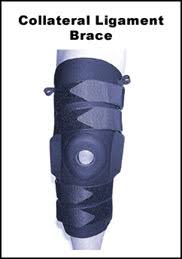In order to better understand how collateral ligament braces work it is important to understand basic knee anatomy and the function of the medial collateral ligament (MCL) and the lateral collateral ligament (LCL). Please review the sections on knee anatomy and on collateral ligament injuries before reading this section.

Ligaments are like strong ropes that help connect bones together and provide stability to joints. In the knee, there are four main ligaments. On the inner (medial) aspect of the knee is the medial collateral ligament (MCL) and on the outer (lateral) aspect of the knee is the lateral collateral ligament (LCL). The other two main ligaments are found in the center of the knee. These paired ligaments are called the anterior cruciate ligament (ACL) and the posterior cruciate ligament (PCL). They are called cruciate ligaments because the ACL “crosses” in front of the PCL.
The MCL and the LCL work together with the ACL and the PCL to keep the knee joint stable during movement. The MCL and LCL provide support at the inner and outer aspects of the knee while the ACL and the PCL lend support at the center of the knee. Tears of the MCL or LCL may be mild (grade I), moderate (grade II) or severe (grade III). MCL and LCL injuries differ from ACL and PCL injuries in that mild to moderate tears have the ability to heal following injury. Grade III injuries to the MCL or LCL are more serious and are often associated with other knee injuries.
After an MCL or LCL injury, the long term goal is to return the individual back to their previous level of activity. A general knee rehabilitation program which includes strengthening exercises, flexibility exercises, aerobic conditioning, technique refinement and proprioceptive (biofeedback) retraining is the most important factor in achieving this goal. Some people with MCL or LCL injuries report an improved sense of stability when wearing a collateral ligament brace.
What is the most common type of collateral ligament brace?
The type of collateral ligament knee brace used depends on the severity of the MCL or LCL injury. The most common style of collateral ligament brace is made of a stretchy neoprene material and has metal hinges on either side of the knee. The hinges allow the knee to bend and straighten while providing support to the inner (medial) and outer (lateral) aspects of the knee. These braces are used with mild to moderate collateral ligament injuries. For moderate to severe MCL or LCL injuries a brace with hinges and a rigid frame would be required. An injured knee can usually be fit with an “off the shelf” brace but occasionally a custom fit brace is required. The type of brace also depends on the size and shape of the individuals’ leg.
What do collateral ligament braces do?
Collateral ligament braces are designed to reduce knee instability following an injury to either the MCL or LCL. In general people with collateral ligament injuries report an improved sense of stability when wearing a collateral ligament brace. These braces are usually recommended for twisting, pivoting, cutting or jumping activities. In addition to providing increased stability to the knee, collateral ligament braces may also decrease the risk of injuring other parts of the knee.
What are the disadvantages of collateral ligament braces?
Collateral ligament braces have some drawbacks. Some people report that they are inconvenient, hot and cumbersome. Sometimes the brace material can irritate the skin. Furthermore, collateral ligament braces do not always work. Sometimes they do not improve the stability of an injured knee especially when the knee is very unstable or there are other significant ligament injuries to the knee. Collateral ligament braces do not return normal stability to the knee, so the knee may still feel unstable under high forces. However, when these braces are fitted properly and when used in conjunction with a general knee rehabilitation program collateral ligament braces can serve an important role in the treatment of MCL or LCL injuries to the knee.
How do I know if I need a collateral ligament brace?
Doctors and physiotherapists who treat MCL and LCL injuries can advise whether a brace would be helpful and where and how to get the correct brace. Collateral ligament braces should be considered as part of the treatment for MCL or LCL injuries of the knee.
Please visit the links section for additional information on collateral ligament braces. Links have been provided to other websites as well as online medical journals. Other knee injury topics can also be accessed.
